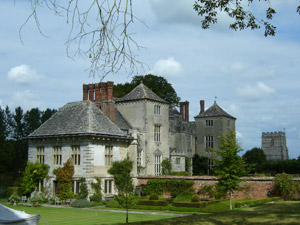
Cranborne
including Alderholt, Blagdon & Boveridge

 |
Cranborneincluding Alderholt, Blagdon & Boveridge |
 |
|
|
Cranborne lies in the valley of the River Crane at the heart of an ancient woodland chase, part of a large expanse of chalk downland that includes nearby Salisbury Plain and Dorset Downs. A royal hunting venue from the time of King John to that of King James I, then later the headquarters of smuggling and poaching gangs, Cranborne is now a hub for rambles and sightseeing, and the home of an educational centre comprising numerous reconstructed historical buildings. The almost 800-strong village is located at the heart of the Cranborne Estate, whose sixteenth century Manor House and famous garden is one of the homes of the Marquess of Salisbury. Until 1849 Alderholt formed the easterly district
of the parish of Cranborne, and was served by a Chapel of Ease, St. Clement,
Bishop & Martyr. In 1846 a new church was consecrated in the new centre of
the village, dedicated to St. James and 3 years later Alderholt was formed
into a new ecclesiastical parish. For many years it was a sparsely populated
tract of heath land, but the village now boasts a population of over 3000
people. |
The parish church of Saints Mary and Bartholomew is Norman in origin, built on the site of a Saxon Benedictine monastery founded in 980 by Aylward Sneaw (Snow) and linked for many years with the abbey at Tewkesbury. Initially, Tewkesbury was subordinate to Cranborne, but the situation was reversed in the late eleventh century when Queen Matilda confiscated the estates pursuant to an alleged act of insubordination by the unfortunate Brictric and awarded them to William Rufus, who in turn gave them to the patron of Tewkesbury. In 1102 the Abbot of Cranborne and 57 monks were removed to Tewkesbury and Cranborne became just a cell and priory. Almost four and a half centuries later, both came to an end as a result of the dissolution of the monasteries, surrendered to Henry VIII on 31 January 1540. |
 |
At Cranborne, the Church with its
fifteenth century eight-belled perpendicular tower built of stone and flint
is the only surviving part of the monastery, whose last remaining buildings
were demolished in 1703. The oldest part of the church is the doorway in the
north porch, which is late Norman. The rest of the building is
pre-Reformation, with the exception of the east end, designed by David
Brandon in 1875. The interior houses a thirteenth century font of Purbeck
marble and a fifteenth century pulpit engraved with the monogram "T.P.",
possibly for Thomas Parker, the Abbot of Tewkesbury and Cranborne from
1389-1421. More recent additions and improvements to the Church include the
chancel screen, the reredos in the Lady chapel and the tower screen, all
carved by Rev. F. H. Fisher, vicar of Cranborne from 1888 to 1910 and the
renewal of the wagon roof in 1958. |
|
|
|
| Bishops' Transcripts | Verwood and Alderholt, Bishops Transcripts Baptisms 1731-1751, 1751-1778, 1780-1812, 1813-1824 1826-1836, 1836-1855, 1857-1879 by Valerie Robbins Marriages 1731-1751, 1751-1778, 1780-1813, 1813-1835 1836-1841 by Valerie Robbins Burials 1731-1751, 1751-1778, 1780-1813, 1813-1835 1836-1855, 1857-1879 by Valerie Robbins |
| Census | 1841 in 7 districts District 1 [Cranborne Town] District 2 [Holwell] District 3 [Alderholt] District 4 [Blagdon] District 4a [Boveridge] District 4b [Oakley, Monckton up Wimborne, Bellows Cross] District 5 [Verwood West] District 6 [Verwood East] Lunatic Asylum 1851 in 6 districts by Valerie Robbins 11A [Cranborne] 11B [Alderholt] 11C [Holwell] 11D [Cranborne] 11E [Verwood] 11F [Verwood] 1861 in 6 districts by Valerie Robbins D1 [Tything Borough and Priory of Cranbrone] D2 [Boveridge/Blagdon/Oakley/Monkton] D3 [Alderholt] D4 [Holwell] D5 [Boveridge Heath] D6 [Verwood] 1871 in 6 districts by Valerie Robbins District 1 [Cranborne] District 2 [Munkton up Wimborne/Oakley/Boveridge/Blagdon] District 3 [Alderholt] District 4 [Holwell] District 5 [Three Legged Cross/Crab Orchard/Verwood] District 6 [Verwood] |
| Directories |
Cranborne Pigot's Directory 1830 by Valerie Robbins Cranborne Kelly's Directory 1880 Cranborne Kelly's Directory 1915 by Valerie Robbins Alderholt Kelly's Directory 1915 by Valerie Robbins Imperial Gazetteer of England & Wales by Kim Parker |
| Wills | Wills proved in the Prerogrative Court of Canturbury By Kim Parker |
| Other | Abbots, Priors
and Vicars of Cranborne by Kim Parker Roll of Honour for WWI & WWII by Kim Parker Cranborne in the books of Thomas Hardy by Kim Parker Ode to the Fleur de Lys Inn at Cranborne by Kim Parker |
| Photographs | Photographs of Cranborne by Kim Parker |
| Links | |
Visitors to Dorset OPC
Copyright (c) 2025 Dorset OPC Project